Glucose Sensing Using Capacitive Biosensor Based on Polyvinylidene Fluoride Thin Film
Abstract
:1. Introduction
2. Materials and Methods
2.1. Fabrication of PVDF Thin Film as a Capacitive Sensor
2.2. Glucose Sensing
2.2.1. Preparation of GOx Enzyme Solution
2.2.2. Preparation of Glucose Solution
2.2.3. Sensor Measurement
3. Results and Discussion
Glucose Sensing
4. Conclusions
Supplementary Materials
Acknowledgments
Author Contributions
Conflicts of Interest
References
- Global Report on Diabetes 2016. Available online: http://www.who.int/diabetes/publications/grd-2016/en/ (accessed on 10 October 2017).
- Zhu, Z.; Garcia-Gancedo, L.; Flewitt, A.J.; Xie, H.; Moussy, F.; Milne, W.I. A Critical Review of Glucose Biosensors Based on Carbon Nanomaterials: Carbon Nanotubes and Graphene. Sensors 2012, 12, 5996–6022. [Google Scholar] [CrossRef] [PubMed]
- Bruen, D.; Delaney, C.; Florea, L.; Diamond, D. Glucose Sensing for Diabetes Monitoring: Recent Developments. Sensors 2017, 17, 1866. [Google Scholar] [CrossRef] [PubMed]
- Clark, L.C., Jr.; Lyons, C. Electrode systems for continuous monitoring in cardiovascular surgery. Ann. N. Y. Acad. Sci. 1962, 102, 29–45. [Google Scholar] [CrossRef] [PubMed]
- Hertzberg, O.; Bauer, A.; Küderle, A.; Pleitez, M.A.; Mäntele, W. Depth-selective photothermal IR spectroscopy of skin: Potential application for non-invasive glucose measurement. Analyst 2017, 142, 495–502. [Google Scholar] [CrossRef] [PubMed]
- Barrio, M.; Moros, M.; Puertas, S.; Fuente, J.M.; Grazú, V.; Cebolla, V.; Marcos, S.; Galbán, J. Glucose oxidase immobilized on magnetic nanoparticles: Nanobiosensors for fluorescent glucose monitoring. Microchim. Acta 2017, 184, 1325. [Google Scholar] [CrossRef]
- Pandey, R.; Paidi, S.K.; Valdez, T.A.; Zhang, C.; Spegazzini, N.; Dasari, R.R.; Barman, I. Noninvasive Monitoring of Blood Glucose with Raman Spectroscopy. Acc. Chem. Res. 2017, 50, 264–272. [Google Scholar] [CrossRef] [PubMed]
- Zhang, T.; Zhang, C.; Zhao, H.; Zeng, J.; Zhang, J.; Zhou, W.; Yan, Y.; Wang, Y.; Wang, M.; Chen, W. Determination of serum glucose by isotope dilution liquid chromatography-tandem mass spectrometry: A candidate reference measurement procedure. Anal. Bioanal. Chem. 2016, 408, 7403. [Google Scholar] [CrossRef] [PubMed]
- Phan, Q.-H.; Lo, Y.-L. Stokes-Mueller matrix polarimetry system for glucose sensing. Opt. Lasers Eng. 2017, 92, 120–128. [Google Scholar] [CrossRef]
- Valiūnienė, A.; Rekertaitė, A.I.; Ramanavičienė, A.; Mikoliūnaitė, L.; Ramanavičius, A. Fast Fourier transformation electrochemical impedance spectroscopy for the investigation of inactivation of glucose biosensor based on graphite electrode modified by Prussian blue, polypyrrole and glucose oxidase. Colloids Surf. A 2017, 532, 165–171. [Google Scholar] [CrossRef]
- Ertürk, G.; Mattiasson, B. Capacitive Biosensors and Molecularly Imprinted Electrodes. Sensors 2017, 17, 390. [Google Scholar] [CrossRef] [PubMed]
- Berggren, C.; Bjarnason, B.; Johansson, G. Capacitive Biosensors. Electroanalysis 2001, 13, 173–180. [Google Scholar] [CrossRef]
- Cheng, Z.; Wang, E.; Yang, X. Capacitive detection of glucose using molecularly imprinted polymers. Biosens. Bioelectron. 2001, 16, 179–185. [Google Scholar] [CrossRef]
- Huang, X.; Li, S.; Schultz, J.; Wang, Q.; Lin, Q. A Capacitive MEMS Viscometric Sensor for Affinity Detection of Glucose. J. Microelectromech. Syst. 2009, 18, 1246–1254. [Google Scholar] [CrossRef] [PubMed]
- Labib, M.; Hedström, M.; Amin, M.; Mattiasson, B. A novel competitive capacitive glucose biosensor based on concanavalin A-labeled nanogold colloids assembled on a polytyramine-modified gold electrode. Anal. Chim. Acta 2010, 659, 194–200. [Google Scholar] [CrossRef] [PubMed]
- Labib, M.; Hedström, M.; Amin, M.; Mattiasson, B. Competitive capacitive biosensing technique (CCBT): A novel technique for monitoring low molecular mass analytes using glucose assay as a model study. Anal. Bioanal. Chem. 2010, 397, 1217–1224. [Google Scholar] [CrossRef] [PubMed]
- Kim, N.Y.; Dhakal, R.; Adhikari, K.K.; Kim, E.S.; Wang, C. A reusable robust radio frequency biosensor using microwave resonator by integrated passive device technology for quantitative detection of glucose level. Biosens. Bioelectron. 2015, 67, 687–693. [Google Scholar] [CrossRef] [PubMed]
- Kotanen, C.N.; Moussy, F.G.; Carrara, S.; Guiseppi-Elie, A. Implantable Enzyme amperometric biosensors. Biosens. Bioelectron. 2012, 35, 14–26. [Google Scholar] [CrossRef] [PubMed]
- Lud, S.Q.; Nikolaides, M.G.; Haase, I.; Fischer, M.; Bausch, A.R. Field Effect of Screened Charges: Electrical Detection of Peptides and Proteins by a Thin-Film Resistor. Chem. Eur. J. Chem. Phys. 2006, 7, 379–384. [Google Scholar] [CrossRef] [PubMed]
- Bankar, S.B.; Bule, M.V.; Singhal, R.S.; Ananthanarayan, L. Glucose oxidase—An overview. Biotechnol. Adv. 2009, 27, 489–501. [Google Scholar] [CrossRef] [PubMed]
- Hartono, A. Pengembangan Material PVDF Untuk Sensor Reaksi Kimia Dan Aplikasinya Untuk Mengukur Kadar Glukosa [Development of PVDF Materials for Chemical Reaction Sensors and Its Applications to Measure Glucose Levels]. Ph.D. Thesis, Bandung Institute of Technology, Bandung, Indonesia, 2015. [Google Scholar]
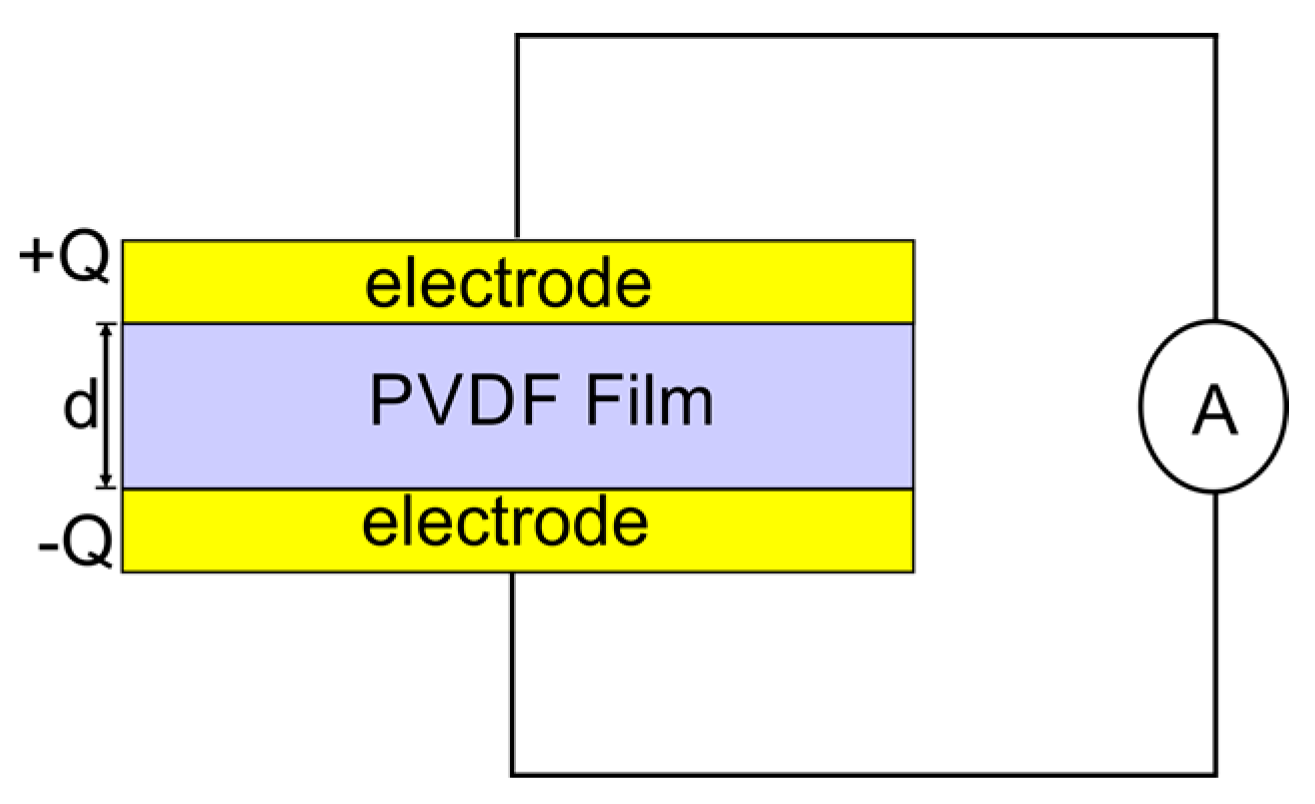

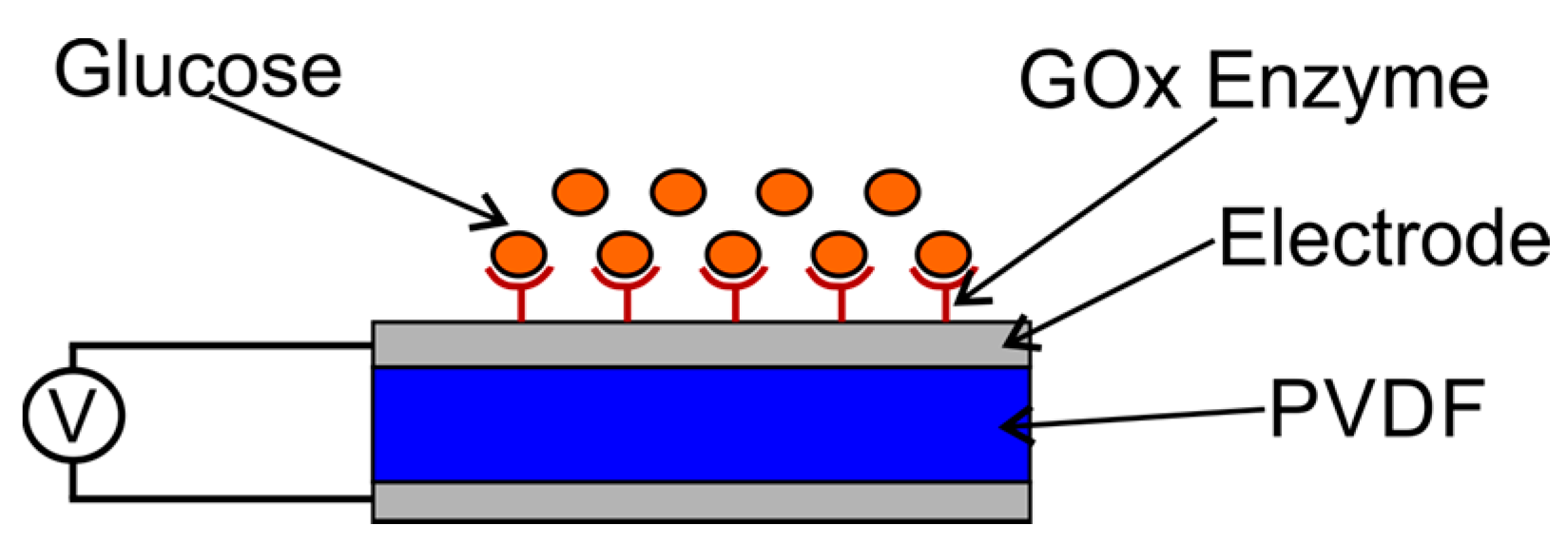

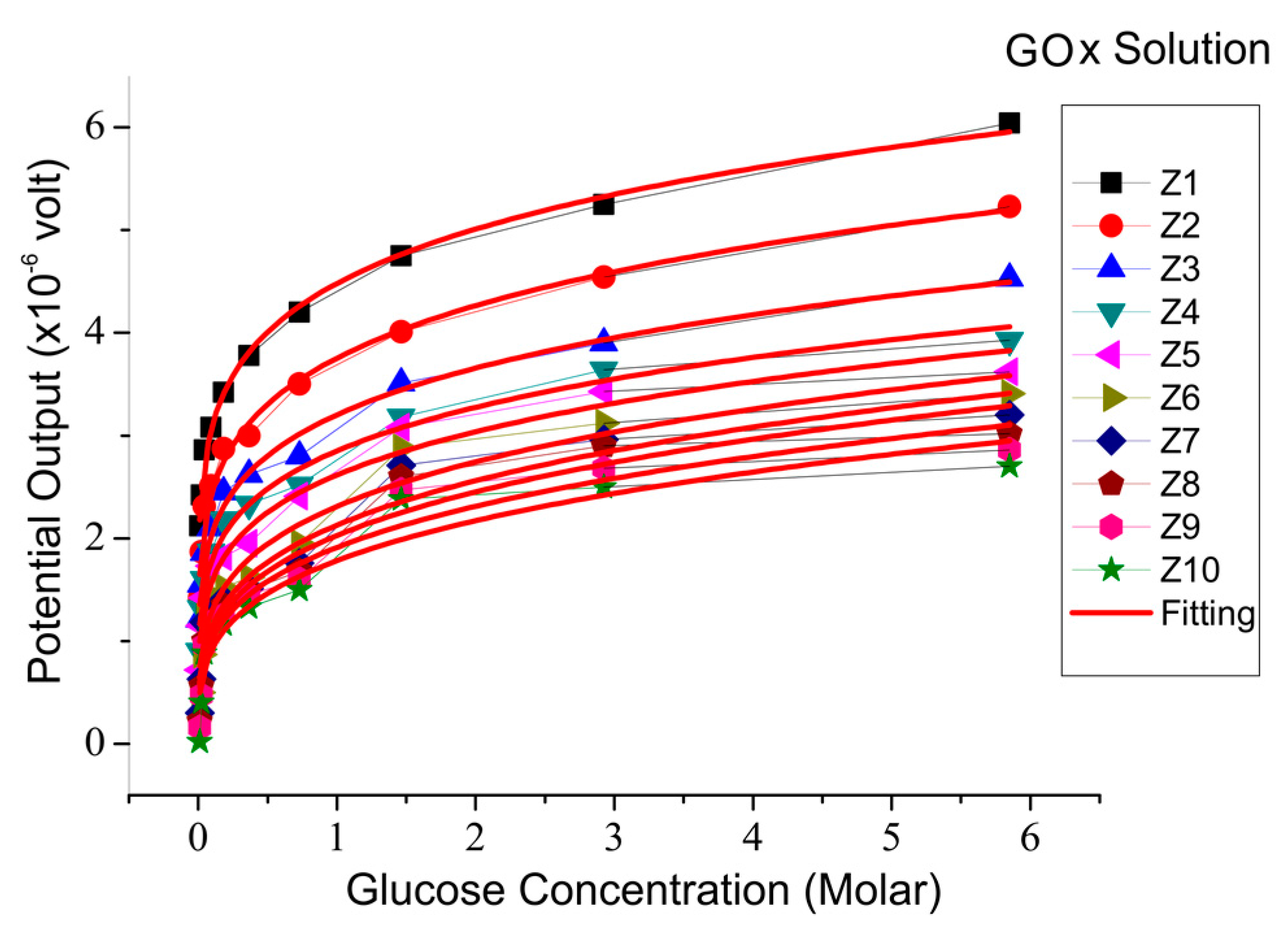
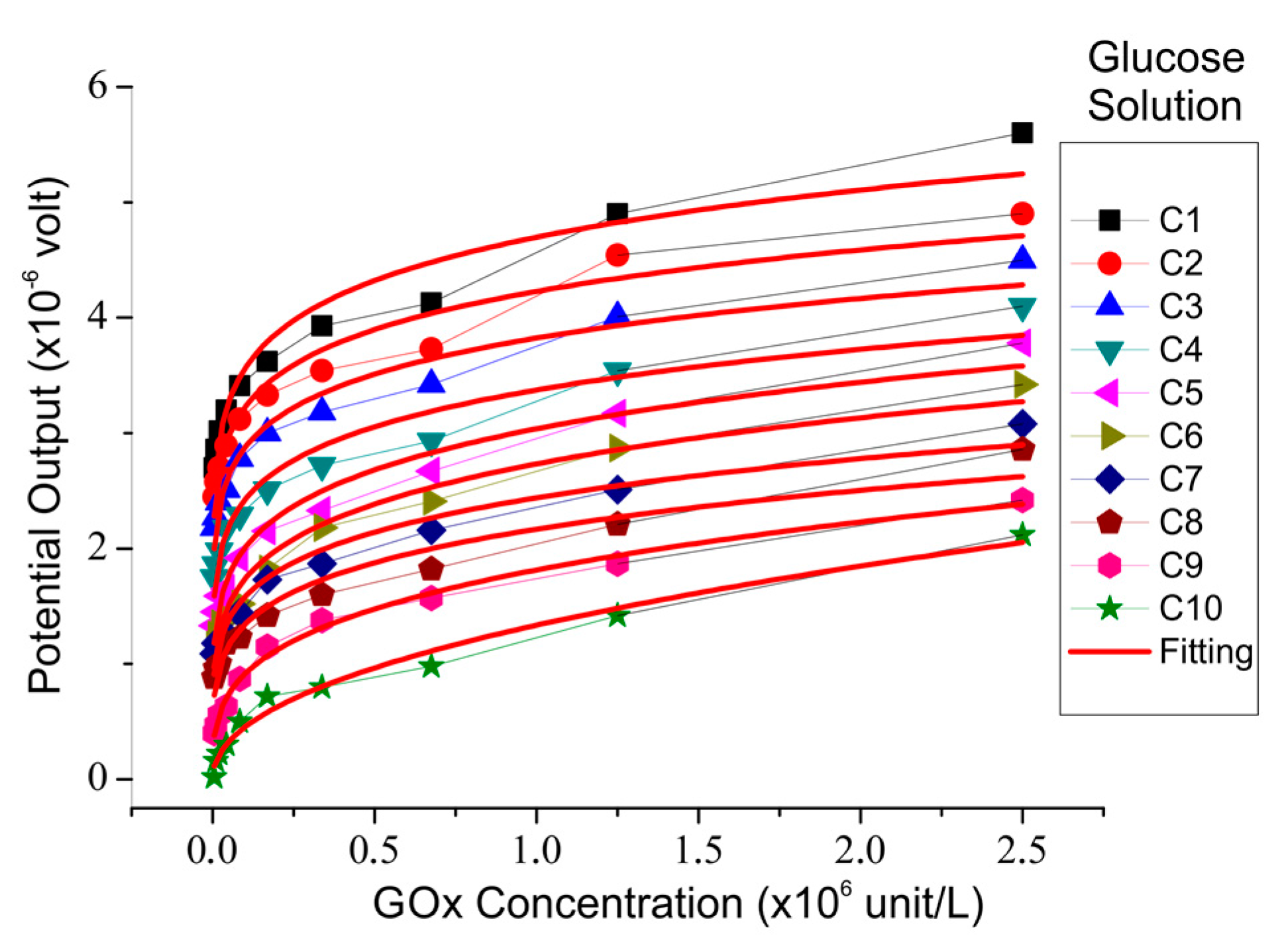
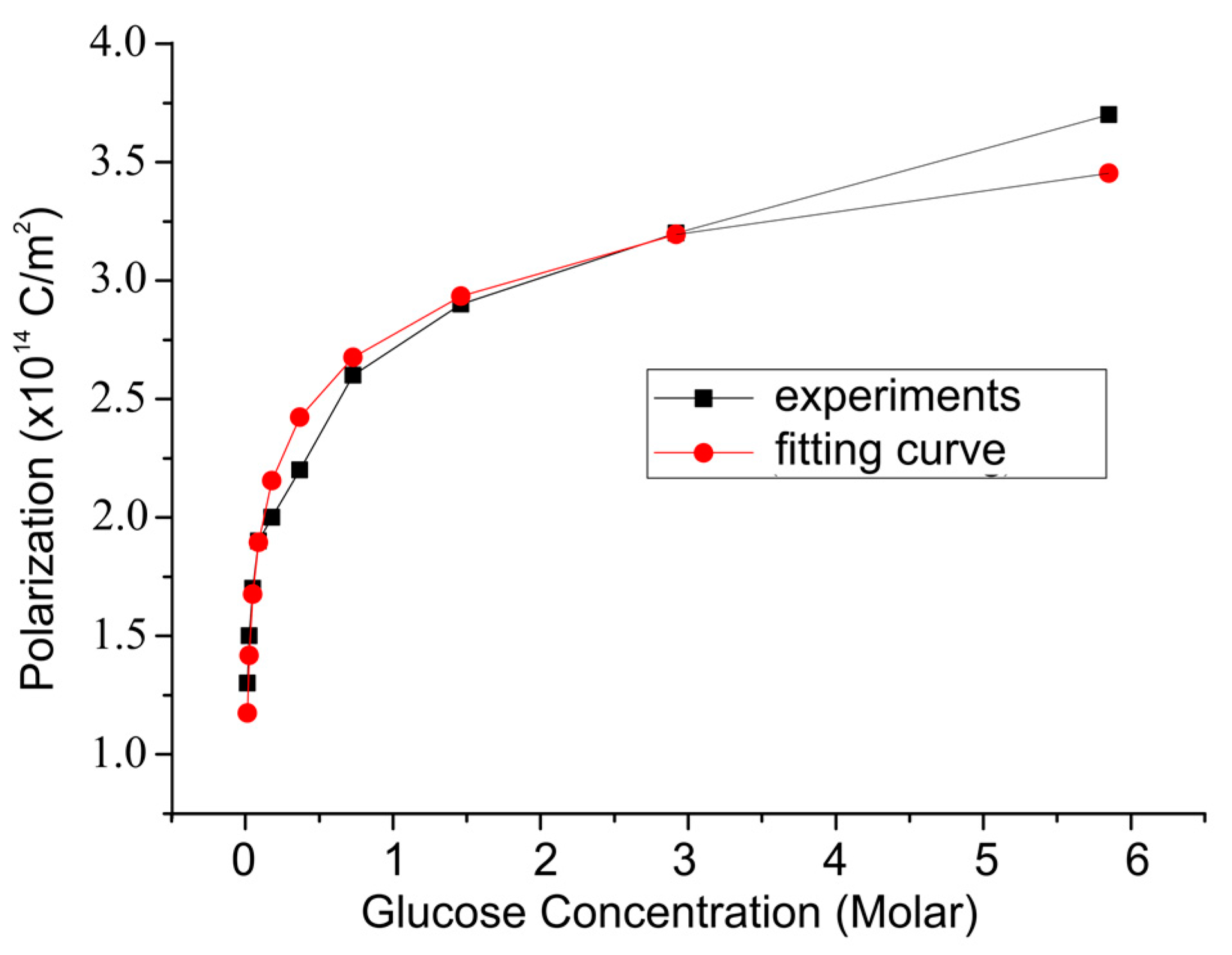
| GOx Solution | Concentration (U/L) |
|---|---|
| Z1 | 2,500,000 |
| Z2 | 1,250,000 |
| Z3 | 625,000 |
| Z4 | 312,500 |
| Z5 | 156,250 |
| Z6 | 78,125 |
| Z7 | 39,062.5 |
| Z8 | 19,531.25 |
| Z9 | 9765.625 |
| Z10 | 4882.813 |
| Glucose Solution | Concentration (M) |
|---|---|
| C1 | 5.85 |
| C2 | 2.92 |
| C3 | 1.46 |
| C4 | 0.73 |
| C5 | 0.37 |
| C6 | 0.18 |
| C7 | 0.09 |
| C8 | 0.05 |
| C9 | 0.025 |
| C10 | 0.013 |
| Enzyme Concentration | Constants | |
|---|---|---|
| (Unit/L) | V0 (×10−6 volt) | R0 (×10−9 mol/s) |
| 2,500,000.00 | 6.360 | −0.359 |
| 1,250,000.00 | 5.416 | −0.430 |
| 675,000.00 | 4.720 | −0.418 |
| 337,000.00 | 3.992 | −0.623 |
| 168,750.00 | 3.607 | −0.986 |
| 84,375.00 | 3.384 | −0.942 |
| 42,187.5 | 3.496 | −0.928 |
| 21,093.75 | 3.054 | −0.948 |
| 10,546.88 | 2.869 | −0.922 |
| 5273.44 | 2.699 | −1.007 |
| Glucose Concentration (M) | V (×10−6 volt) | Q (×10−14 C) | I (×10−15 A) |
|---|---|---|---|
| 5.85 | 6.04 | 4.83 | 1.61 |
| 2.92 | 5.25 | 4.20 | 1.40 |
| 1.46 | 4.75 | 3.80 | 1.27 |
| 0.73 | 4.20 | 3.36 | 1.12 |
| 0.37 | 3.78 | 3.02 | 1.00 |
| 0.18 | 3.42 | 2.74 | 0.91 |
| 0.09 | 3.08 | 2.46 | 0.82 |
| 0.05 | 2.86 | 2.29 | 0.76 |
| 0.025 | 2.42 | 1.94 | 0.65 |
| 0.013 | 2.12 | 1.70 | 0.57 |
| Sensor Method | Dynamic Range (M) | Limit of Detection (M) | Sensitivity | Ref. |
|---|---|---|---|---|
| Immobilization of Concanavalin A (ConA) on gold nanoparticles incorporated on the tyramine-modified gold electrode | 1.0 × 10−6–1.0 × 10−2 | 1.0 × 10−6 | A negligible loss in sensitivity after 10 cycles (7.5%) | [15] |
| Immobilization of Concanavalin A (ConA) and replacement of small glucose with the large glucose polymer | 1.0 × 10−5–1.0 × 10−1 | 1.0 × 10−6 | N/D | [16] |
| Glucose solution over a PVDF film coated with the GOx enzyme | 1.3 × 10−2–5.85 | 1.3 × 10−2 | N/D | This work |
© 2018 by the authors. Licensee MDPI, Basel, Switzerland. This article is an open access article distributed under the terms and conditions of the Creative Commons Attribution (CC BY) license (http://creativecommons.org/licenses/by/4.0/).
Share and Cite
Hartono, A.; Sanjaya, E.; Ramli, R. Glucose Sensing Using Capacitive Biosensor Based on Polyvinylidene Fluoride Thin Film. Biosensors 2018, 8, 12. https://doi.org/10.3390/bios8010012
Hartono A, Sanjaya E, Ramli R. Glucose Sensing Using Capacitive Biosensor Based on Polyvinylidene Fluoride Thin Film. Biosensors. 2018; 8(1):12. https://doi.org/10.3390/bios8010012
Chicago/Turabian StyleHartono, Ambran, Edi Sanjaya, and Ramli Ramli. 2018. "Glucose Sensing Using Capacitive Biosensor Based on Polyvinylidene Fluoride Thin Film" Biosensors 8, no. 1: 12. https://doi.org/10.3390/bios8010012






